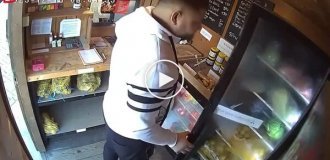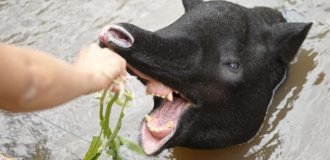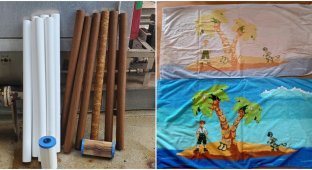Reflecting on the phenomenon of Vivian Maier, it is impossible not to admit that the gigantic archive of street photographs, miraculously found after her death, which she took for forty years while working as a simple nanny and caregiver, raises as many questions as the biography of one of the most enigmatic photographers of our time.
Photo captions only where they were in the source.
Self-portrait 
She ironically called herself a spy, then a woman of mystery, signed checks and documents with fictitious names, hid her place of birth, naming France, then New York, said that she learned English from theater plays, her supposedly "fake" French accent aroused suspicion. It was as if Mayer deliberately mixed up the cards so that she would not be exposed and made famous before her time. Hundreds of thousands of negatives and undeveloped films, which she, like her main life treasure, carried with her everywhere and carefully preserved, many of her own self-portraits, seemed to be waiting for the moment when the strange and lonely elderly woman in a wide-brimmed hat would disappear, and she would come to the forefront - Vivian Maier - an original photographer, a singer of street life.
Chicago 
Chicago 
Chicago
[th umb]200_files/8b2a5675e862b7db261265cd0bda533f.webp[/thumb]
Chicago 
Chicago 
Chicago.1977. 
Chicago, October 1976 
Chicago, August 1975 
Chicago, 1979 year 
Frank Sinatra, 1960. 
Audrey Hepburn at the Chicago premiere of "My Fair Lady" at the RKO Palace Theater, October 23, 1964. 
New York 
New York
[thumb]https://cn22.nevsedoma.com.ua/p/28/2858/200_files/45ebb474aa7a98212a 17f0ea787124c0.webp[/thumb]
New York 
New York 
New York rk 
New York 
New York
[thumb]https://cn22.nevsedoma.com.ua/p/28/2858/200_files/d26e125a07e36d 54987cc09cf65c048c.webp[/thumb]
New York 
Milwaukee 
May 1976 
Kirk Douglas 
Canada 
Canada 



[thumb]https://cn22.nevsedoma.com.ua/p/28/2858/200_files/4934 d9034f2c5667acc2ed5ee99c38d8.webp[/thumb] 
[thumb]https://cn22.nevsedoma.com.ua/p/28/2858/200_files/a04980193b0657e36a67bd1616ebf ca8.webp[/thumb] 



[thumb]https://cn22.nevsedoma.com.ua/p/28/2858/200_files/c436c c695ca4f191f088ef2d137a4cc7.webp[/thumb] 
[thumb]https://cn22.nevsedoma.com.ua/p/28/2858/200_files/4f3d92362aaf40129f7cf5bd1bf3ac 4c.webp[/thumb] 

Looking at Vivian Maier's photographs, another recognized master of street photography, Joel Meyerowitz, noticed that the Rolleiflex camera, which she almost never cheated on, was perfect for camouflage. You don't have to hold the camera up to your face when you want to take a picture. This angle gave the heroes of her photographs an effect of elevation - ordinary passers-by, tramps, poor people, children, couples in love, remarkable details captured, in Maier's photographs look important and exceptional. It seemed that she cared about everything - crying children, the drama of street scenes, she noticed painful injuries, recorded pain and beauty. The provocative sharpness of her shots "scratches" with their undisguised passion, imperturbable, almost childish curiosity allowed her not to take her eyes off what was not customary to look at.
A street photographer must be social, but equally he must be a loner. Vivian Maier's total loneliness is the main feature of her biographical portrait, which, thanks to numerous researchers, is only now beginning to take on clearer contours. From archival documents and birth certificates it is known that Vivian Maier was born on February 1, 1926, in New York. Her mother, Marie Jausseaux, was born French, and her father, Charles Maier, was an Austrian. The couple already had a child, a boy named Karl, who was recorded as illegitimate at baptism. When Karl turned 5, he was placed in an orphanage and later given to the care of his grandparents. The Maiers had divorced by that time. Vivian stayed with her mother, who for some time moved her daughter to her homeland in France, the small Alpine village of Senn-Bonnet-en-Chapsaur. Nothing is known for certain about her mother's occupation. Vivian grew up traveling between the French province and New York with her mother and her close friend Jeanne Bertrand, who was a well-known portrait photographer. There is an assumption that it was she who gave Vivian her first photography lessons. The girl began taking pictures in France (presumably in 1949). Her first camera was a modest amateur Kodak with one shutter speed, without focus and aperture controls. Collectors have found a series of three female portraits among Mayer's early works, which are most likely portraits of her mother. She herself does not mention this or write about it. The mystery of her family's disunity seems to weigh on several generations. Vivian's mother also barely communicated with her mother, who was a cook in wealthy New York homes. The early divorce of her parents, the death of her father (an engineer by profession), who deprived Vivian and her brother of an inheritance and, according to rumors, was a heavy alcoholic. Brother Carl, who appears under different names many times for inexplicable reasons, is known to have been a drug addict and to have been in a psychiatric hospital with a diagnosis of paranoid schizophrenia. Vivian Maier biography researcher Ann Marks suggests that this family background may explain her mysteriousness and secrecy:
"How many families would want to hire a nanny with an abusive alcoholic father, an unstable mother, and a drug-addicted brother who had a criminal record and lived in psychiatric institutions?"
Working as a nanny was not a calling for Maier, but it was an excellent opportunity to combine it with her lifelong passion - photography. Upon arrival in New York, she got a job in a garment factory, but soon quit. As she herself said: "I wanted to work where I could walk, look at the world, see the sun." In 1952, Maier bought her first Rolleiflex and her New York odyssey began. She carefully documented street life, paid attention to historic buildings that were being torn down, she was drawn to the life of the poor, Maier considered herself to be lower class all her life and was proud of it. In 1956, she moved to Chicago, and for many years became a nanny for three boys from the Gainsbourg family. Despite her strangeness and sharp character, the children adored her. Together they explored remote areas of the city, wandered through old cemeteries, Maier took the boys to the last showings of films, picked strawberries with them in a ravine. Each of their trips was like an adventure, she showed how the poor lived and insisted that children from a rich family should be aware of the lives of ordinary people.
Changing employers one after another, when her children grew up and her services were no longer needed, Maier carried with her huge boxes of negatives, newspaper clippings, notes, documents, undeveloped films and printed photographs. She maniacally recorded life. In crowded places, supermarkets, she asked people about important political events, asked their opinions on other issues and recorded everything on tape cassettes. Once, moving to another place of work, Vivian mentioned that she "carried her whole life with her." With each passing year, Maier became more and more strange, and her passion for hoarding acquired threatening proportions. When in old age she could not work and became very poor, the Gainsbourg brothers took on the care of their old nanny. They rented an apartment for her in a good area and took care of her until the last days of her life (Vivian Maier died at 83, she slipped on ice and got injured, despite optimistic prognoses of doctors, she did not recover).
In 2007, due to overdue payments for storage of things, part of her collection was confiscated and sold at auction. A box containing about 30 thousand negatives was purchased for $ 380 by 25-year-old real estate salesman and historian John Maloof. Having scanned some of the images and posted them on the Internet, he caused a wave of admiration, the pictures went viral and Maloof realized that he had discovered a unique photographer. He found Vivian Maier's name scratched on a piece of paper at the bottom of the box. Search engines did not help him at all. Only two years later, in 2009, John Maloof came across an obituary published in the Chicago Tribune. The collector became literally obsessed with Maier's legacy, he found her former employers, trustees and bought part of the archive of works, personal items, absolutely everything that belonged to the photographer. Her first posthumous exhibition was held in Chicago, which became a real sensation. In 2013, thanks to the efforts of John Maloof, a documentary film "Searching for Vivian Maier" was filmed, which received an Oscar nomination.
The current legacy of one of the most enigmatic photographers of our time is about two thousand rolls of black and white film and 700 color films (in the 1970s, Maier decided to switch to color photography, shooting mainly on 35-mm Kodak Ektachrome film), more than three thousand pictures printed by her own hands, 150 thousand negatives, which show life on the streets of New York, Chicago, Los Angeles, the American Southwest in the 1940s-70s, an amazing archive of works from Maier's short trip to Italy, Egypt, Beijing, Bangkok and other countries.
Vivian Maier never published a single photograph of herself in her entire life. She was lonely, never married or had children, Maier had no close friends. Her phenomenally sensitive, piercing works are a striking contrast to her external isolation and alienation. In "Walks of a Lonely Dreamer" - a kind of ode to loneliness, the writer and philosopher Jean-Jacques Rousseau speaks with pain about a man "the most loving among men, but exiled from their midst." The works, notes, and things left by Vivian Maier became the perfect puzzle, which, as she most likely assumed, would be solved only after her death.
"Maybe it is the best way for her that all this happened after her death," one of Maier's students said about the surging world fame. "It would have made Viv happy, because in life, all this attention, she would have found it overwhelming."
Strange, crazy, lonely, mysterious, brilliant, talented, with a dark side. Controversies about the works and life of Vivian Maier, it seems, will not subside for a long time. Her legacy has also become a reason for litigation between collectors and potential heirs. It is unlikely that this is what she wanted, but, scrupulously collecting all her baggage, many years of work filled with love and attention to people, she knew for sure that her business would not disappear, that her lonely, strange life would finally become important.
Numerous works of the photographer can be seen on the website dedicated to her creative legacy and life path.
Author: Inna Moskalchuk
Add your comment
You might be interested in:






















